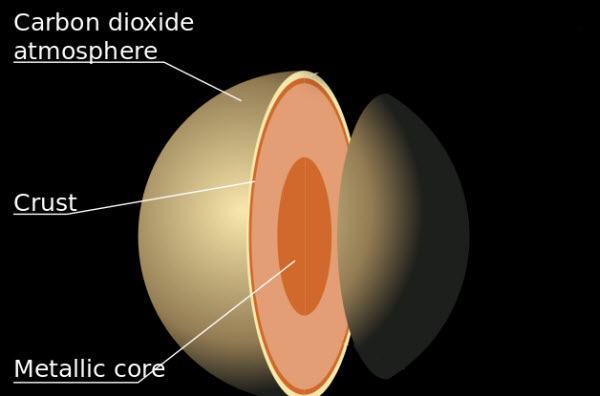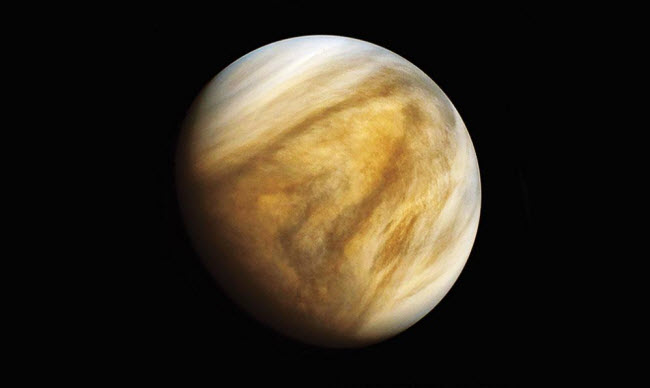Venus is the second closest planet to the Sun in our solar system and ranks sixth in size. Often referred to as Earth’s twin due to their similarities, Venus, however, presents a stark contrast when approached. It is essentially a hellish world with surface temperatures high enough to melt lead, exceeding even those of Mercury, the closest planet to the Sun. This extreme heat is due to its thick atmosphere, which traps heat. Additionally, a day on Venus is longer than its year, and the planet lacks any seasonal changes. It is believed that Venus might have been habitable like Earth in the distant past, but severe global warming has since turned it into a barren wasteland. The planet’s surface endures high temperatures and pressures. Studying Venus is crucial for understanding how such a transformation occurred and to prevent a similar fate for Earth.
Named after the Roman goddess of love and beauty, Venus is one of the seven bright celestial objects visible to the naked eye, including the Sun, Moon, and five planets (Mercury, Venus, Mars, Jupiter, and Saturn). Venus is unique among the planets as it is named after a female deity. Its brightness makes it visible during the day, and it lacks any moons. The planet is enveloped in a thick layer of highly reflective sulfuric acid clouds. Unlike other planets, except Uranus, Venus rotates in the opposite direction, causing the Sun to rise in the west and set in the east.
What is Venus’ Size and Distance?

Venus is close to Earth, making it easily visible to the naked eye. Its diameter is about 12,104 kilometers, nearly the same as Earth’s, and it is the brightest object in the night sky after the Moon. Venus is approximately 108 million kilometers from the Sun and can come as close as 61 million kilometers to Earth. Unlike Mercury, Venus does not approach Earth as closely. Observations through telescopes show that Venus undergoes phases similar to the Moon, appearing full, half, or crescent. The complete cycle of these phases takes 584 Earth days, much longer than the Moon’s monthly cycle. Galileo’s observations of these phases provided crucial evidence for the heliocentric model of the solar system.
What About Venus’ Orbit and Rotation?
A day on Venus would be confusingly long. If humans could survive its extreme heat of 475°C, a day on Venus would equal 243 Earth days, longer than its year of 225 Earth days. Due to its slow rotation, the time from sunrise to sunset lasts 117 Earth days, and the Sun rises in the west and sets in the east. Venus’ axis is tilted by only three degrees, preventing seasonal changes unlike Earth’s 23-degree tilt that causes seasonal variations.

How Did Venus Form?
Venus and Earth share similar sizes and internal structures, leading to challenges for planetary scientists studying their formation. Both had similar early conditions, but Venus now suffers extreme conditions while Earth supports life. Venus likely formed from a gas and dust disk around the Sun about 4.6 billion years ago. Understanding Venus’ formation can help us better understand Earth and rocky planets around other stars.
Venus’ Structure

If Earth and Venus were split and placed side by side, they would appear quite similar. Both have iron cores surrounded by hot rocky mantles and thin outer crusts. Both planets experience changes in their crusts due to heat and pressure, possibly leading to volcanic activity. Earth’s tectonic plate movements continually reshape its surface, a process that may have occurred on Venus in its early history. NASA’s Magellan spacecraft mapped Venus’ surface in the 1990s, revealing volcanic terrain, recently reshaped areas, and mountain ranges.
Surface Features
Venus’ surface features include valleys, high mountains, and thousands of volcanoes. Areas on Venus are named after historical and mythological women, such as Ishtar Terra and Aphrodite Terra. Despite its harsh conditions, Venus has fewer craters than other rocky planets, and features like pancake domes and tesserae (complex terrains) are prominent. The surface is continually reshaped by volcanic activity.
Atmosphere
Venus’ atmosphere is extremely harsh, with surface temperatures reaching 482°C, making it hotter than Mercury. The atmosphere is mainly carbon dioxide, similar to the greenhouse gases affecting Earth, with sulfuric acid clouds. At higher altitudes, temperatures and pressures decrease, leading to strange phenomena like dark streaks absorbing ultraviolet light. These streaks may be due to fine particles or chemical compounds, and there is a possibility, though slim, that they might be microbial life.
Magnetic Field
Despite Venus having a similar size and iron core to Earth, it lacks an internal magnetic field. Instead, it has an induced magnetic field formed by interactions between the solar magnetic field and its outer atmosphere. Solar ultraviolet rays ionize the gases in Venus’ atmosphere, creating an ionosphere, while solar wind interacts with this ionosphere, generating a magnetic field around Venus.
Space Missions to Venus

Venus was the first planet to be explored by spacecraft when NASA’s Mariner 2 flew by in December 1962, gathering important data about its atmosphere and surface. Subsequent missions, such as Magellan in 1990, used radar to map Venus’ surface, revealing volcanoes and lava channels. Recent missions include ESA’s Venus Express (2006-2014), JAXA’s Akatsuki Venus Climate Orbiter (since 2016), and NASA’s Parker Solar Probe, which conducted flybys of Venus in 2020, discovering puzzling changes in its upper atmosphere related to the solar cycle. These missions continue to enhance our understanding of Venus and its differences from Earth.
